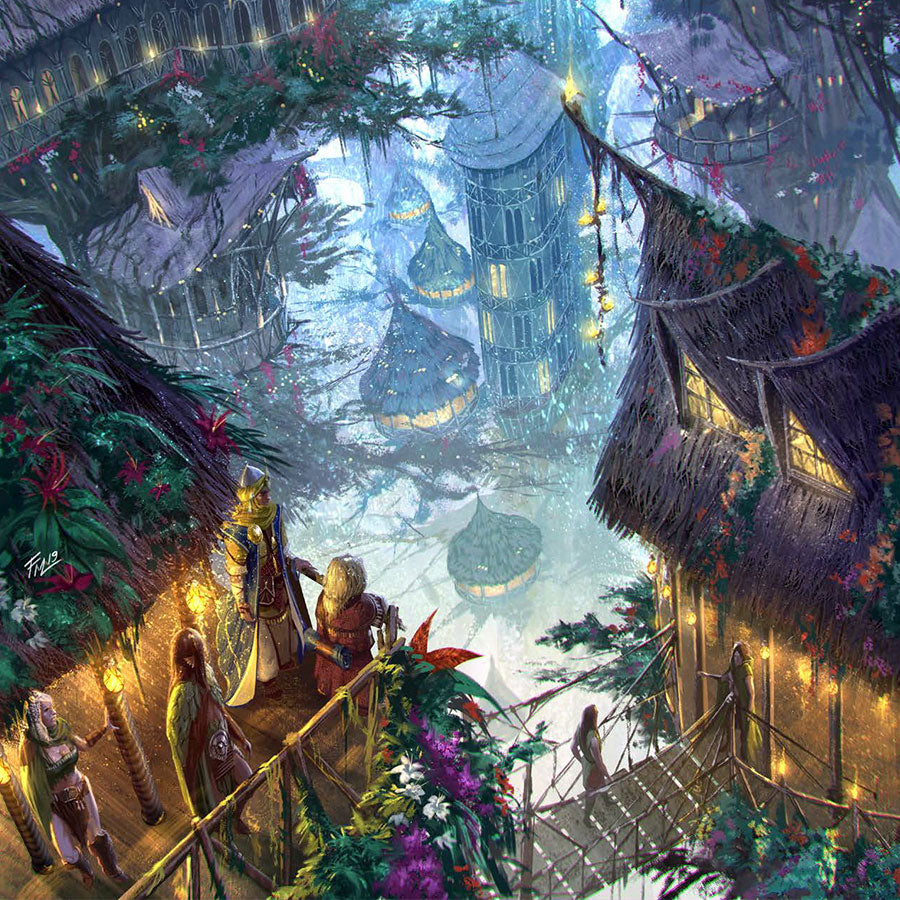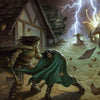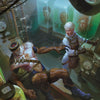Make D&D Travel Exciting with Points of Interest

Nearly every D&D player has experienced boring travel. You know exactly what it looks like. As you travel to get to the location where your next adventure takes place, your game master throws random encounter after random encounter at you. And you can’t help but wonder, what’s the point?
Combat for the sake of combat – because, you know, with random encounters the monsters always seem to just attack. Is the game master just padding out their game? Are they stalling because they aren’t ready for the next adventure? Why can’t we just get to the destination where the REAL adventure takes place?
If you’ve experienced this in Dungeons & Dragons, you know it sucks. You dread it and rightly so. Well, I’m here to tell you that there is a better way to do travel in besides just throwing random encounters at characters. And that’s using a point of interest system.
Now, I want to be clear, there is nothing WRONG with random encounters. In fact, I use random encounters in my RPG games. However, the way that I often see random encounters implemented is the actual problem, and I fully intend to make a dedicated article about how to make random encounters better so that I can do the topic justice.
Today, though, we’re just going to discuss a Point of Interest (POI) system. By the way, you can pick up our full Point of Interest System—or our Big Ruleset Bundle which contains the POI system and lots of other useful 5e rulesets—if you’d like to get all the details as a printable PDF.
Watch or listen to this article by clicking the video below.
Why Bother?
Before we talk about HOW to implement a point of interest system, however, first I want to discuss what we’re trying to ACCOMPLISH during travel. What are our goals as game masters? Because if we don’t have any goals when featuring travel from point A to point B in our games, then we might as well skip it. There’s no point. Doing travel just to do travel is stupid. We need to make it have a purpose.
As a game master, I think there are several worthwhile goals you might have for travel in your games:
First, you may want to show the players glimpses of the wider world so that they might see some of the locations, lore, and interesting things that are out there. This is probably the best reason to feature travel. When the scope of your game is extremely limited, and the players only see two cities and a handful of other locations where adventures take place, your game world can feel contrived and empty. If they never experience firsthand what else is in your world, it might as well be empty as far as your players are concerned. One of the best ways to bring your world to life is to show it off to your players, and travel is a prime opportunity for that.
Second, if the wilderness is a dangerous place in your world, you may want your players to experience that firsthand, and when they travel is the prime moment to do that.
Next, showing off and using the variety of creatures we have in monster manuals and bestiaries is an admirable goal, and a great way to do that is during travel. Yes, you can do that in adventures, but most adventures have themes and feature similar creatures, making it more challenging. But one-off encounters with a variety of denizens are quite easy to work into travel. This serves to give your players variety, and you, as the game master, an opportunity to use more of the cool monsters that you read about.
Now, in my games, when my players travel, I generally use a combination of random encounters and a point-of-interest system, and they BOTH serve to accomplish the goals I just listed.
For many people who have experienced horrible travel in tabletop roleplaying games, I think the temptation is to throw it out and perhaps implement some sort of fast travel system, such as what we have in Skyrim and other video games. However, that would be missing out on a wonderful opportunity for both great fun and immersing players more fully in the game world.
What Are Points of Interest?
Okay, so what is a point of interest system, and how can you make one for your game? First, I want to state that it is NOT the same as a hex crawl. Hex crawls are a STYLE of game; whereas points of interest are something that you tack onto whatever style of game you may be running. By the way, I made an entire video about Hex Crawls that you can check out later if you want to know more about them.
At its heart, a point-of-interest system creates a way for characters to discover cool and interesting things while traveling. The system's core philosophy is to create an immersive environment where characters can discover hidden locales and dangerous secrets without the game master having to design every detail of the world in advance.
There are two basic elements of a point of interest system: creating points of interest and then PLACING the points of interest. We’ll discuss both in that order.
When you’re designing a point of interest – let’s just call them POIs going forward, shall we? – you first want to determine the TYPE of POI it will be. You can choose from ruins, buildings, magical regions, wild regions, unknown settlements, and pretty much anything else your imagination can come up with.
You’re basically figuring out WHAT the cool location or thing is that the characters will encounter. And then, of course, you want to work out a description of that place since your players will be interacting and exploring it. Now, they might just walk on by and ignore it… and we’re actually going to discuss what a GM should do if players ignore points of interest later in this video.
What’s in the Point of Interest?
Next, you want to decide if there will be any creatures present, and if there are, design that encounter or encounters. There certainly don’t have to be creatures present, of course. If your players just discovered a wizard’s tower that disappears every day at dawn, teleporting to a new place in the world, it may be empty. Or it may have a mad old man within who has been waiting for decades to be taken back to his home…eventually…maybe.
Now, when I’m doing POIs for my games, I like to include creatures. I see it as a way to use more cool monsters from the books, though they aren’t always hostile. But you may prefer to focus more on just having the LOCATION be the point and worry less about creatures being present. This is a question of personal taste.
Finally, every point of interest should include a DISCOVERY. These don’t have to be world-shattering secrets or even anything fancy. They just need to be something interesting that players can come across. Part of your goal here might be to show them more about the world and its lore.
For instance, in the D&D game I run for patrons, they once game across a thriving jungle in the middle of a bleak wilderness, and as they explored further, they found a tribe of lizardfolk that they befriended and a mighty dragon of near god-like proportions who held information that furthered their characters’ overall campaign mission. So, there was a mix of small nuggets and a massive reveal of information and lore about the world. All baked into a jungle point of interest that my group LITERALLY almost walked past because they had seemingly more important things to do.
Discoveries!
Now, your points of interest certainly don’t have to do with the main campaign, though they may. I would say that about 90% of my POIs are completely unrelated to the campaign; I generally use them to unveil more about the world, not more about what the characters are already encountering. That means that each point of interest should either have or be something that the characters can discover, preferably something that’s new and exciting to the campaign.
Here are some TYPES of discoveries you might include in your POI system: militaristic, magical, religious, commercial, and criminal. Militaristic sites contains something of military significance; magical discoveries relate to the use and study of magic – tomes, magic circles, and magic items, for instance; religious discoveries have to do with the gods and the priesthood – think statues or rites or churches in the wilderness; commercial discoveries are ways for the characters to make money; and criminal discoveries could be things like a smuggler’s den to a serial killer’s burial grounds. My example above was in part a commercial discovery because my players arranged a trade relationship with the lizardfolk tribe in the jungle.
Where Do They Go?
Okay, now let’s say that you create half a dozen or so points of interest for your game. Where do you place them? How do characters encounter them? There are two answers to this.
The first is to place them at static positions in your game world, and then as characters travel, they may or may not come across them. This has the advantage of “realism” but the strong disadvantage of leaving an important game element – discovering cool stuff in the world – to chance.
I personally prefer the second option: dynamically placing POIs wherever I need them to be depending on where the players are traveling to. For instance, let’s say my players haven’t come across that jungle yet, and I decide that will be the next POI they encounter in the game. Cool, so wherever they happen to travel, whether its to Khoss Gurkux or Vimkax or Oss Jimkor, they will come across the jungle and I’ll place it on the overland map wherever I need to.
Now, you might argue that’s not realistic and might break immersion, but think about it. From the players’ standpoint, they have no idea where that jungle is “supposed” to be. They have no idea that it was only on the road to Khoss Gurkux because that’s the next place they went to.
From their point of view, that jungle was ALWAYS on the way to Khoss Gurkux. And the advantage this method grants you, the game master, is that you can CURATE the game and place that POI just where you need it to be to ensure travel is interesting and accomplishing the goals we mentioned at the beginning of this video.
How Often Should They Show Up?
Okay, great, so let’s say we are dynamically placing POIs as our players travel. Well then, how frequently should they run across a POI? My rule of thumb is that when they are traveling to a place they have NOT BEEN TO BEFORE, they will discover at least one POI, or perhaps more if the journey is a long one.
However, if they are traveling someone they HAVE been to before, then maybe they won’t find any. Of course, if characters are only ever traveling to the same two cities, then maybe I will throw one in from time to time. It’s really up to you, the game master; just remember your goals with POIs, and that you don’t want to overdo them. They are a tool to be used as PART of the game; the adventures groups go on will usually remain the primary focus of the game, not points of interest.
My Players Are IGNORING Them!
However, what do you do if your players IGNORE your points of interest? Yes, well, that’s a risk you run, of course. Players might walk right by them, just as mine almost did with that jungle. My suggestion is twofold: If players want to ignore them, ultimately, they should be allowed to do so. However, if you find players always ignore them, you might speak with them and let them know that those POIs contains cool and sometimes useful stuff and information, if they choose to engage with them.
If your players still aren’t interested and just want to do the quests, you MIGHT just stop making POIs. However, there are other approaches, too. You can build POIs to motivate characters to explore them. Imagine if in the middle of the jungle, my players had seen a crystal spire rising up with a ruby as large as a horse at the top. I bet you my weight in gold every single player would have been like, “time to go into the jungle, baby!” What I’m getting at is that you should consider presenting your points of interest in ways that APPEAL to your players and make them want to investigate.
Another thing you can do if players ignore a POI is ask yourself, “Okay, now what?” That is, if the players ignore the POI, does something happen? Are there consequences? What can you do in the game world that reflects their decision not to engage with the POI? This is not PUNISHING players or their characters; let’s be clear. This is the game master considering how events might play out as a result.
For instance, if my characters had not gone into the jungle, perhaps they would have encountered the lizardfolk tribe in Khoss Gurkux two sessions later and discovered that the greatwyrm had driven them from their jungle home. And the lizardfolk might request that they help them get their homeland back. And that’s just one quick thought; there are countless other ways I could have used that untouched POI in the game world, even if my players had ignored it.
The Big Ruleset Bundle!
Now, if you’d like to get this Point of Interest System in written form and save yourself the hassle of taking notes, you can get it here. If you would like to get your hands on this ruleset AND many others that we have created over the years, check out our Big Ruleset Bundle, which includes the Point of Interest System and half a dozen more rules for your games!
-
Posted in
Game Master How-To Articles







